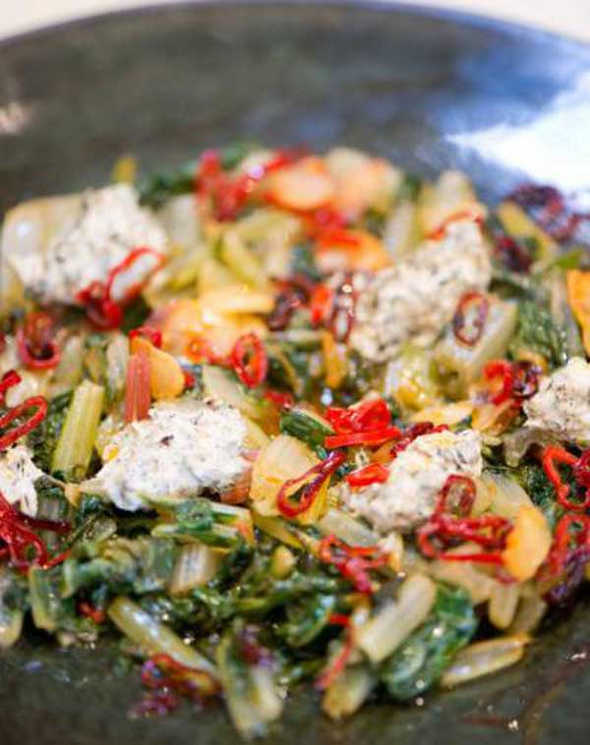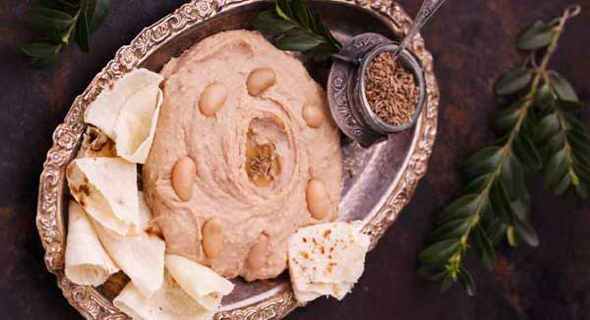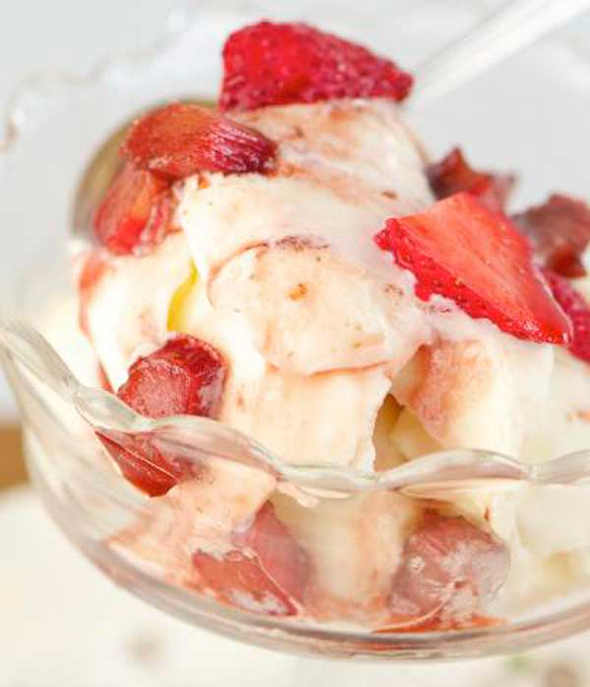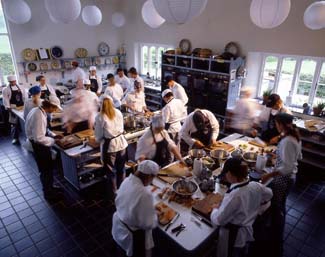The Darina Allen Column

This month Darina reflects on some of the highlights of the 2016 Kerrygold Ballymaloe Lifest
Well, the Kerrygold Ballymaloe Literary Festival of Food and Wine is over for another year - it was great to put my feet up for the first time in several days. It was quite an event with thousands of people converging on East Cork for the weekend.
Over 30 nationalities that we know of and as one hassled visitor complained to me ‘there wasn’t a bed between here and Cork’. Fortunately we found her one, but the event certainly created a huge buzz and generated a lot of excitement in the greater area.
There were many highlights…. the thought provoking 15 minute talks in the Grainstore on a whole range of topics. Food in a Warzone with Kamal Mouzuwak from the Lebanon, Seaweeds eat them, meet them with Prannie Rhatigan, Ella McSweeney chaired a panel on Farming the Soil, Prue Leith founder of Leiths Cookery School in London spoke about her life in food.
Elizabeth Luard, Sacred Food was also riveting but one of the most thought provoking of all was Professor Ted Dinan of UCC’s talk on the relationship between our gut and our psychological wellbeing.
Ari Weinzweig from Zingerman’s in Ann Arbor in Michigan’s talk was entitled ‘A Lapsed Anarchist’, his subject, how to create a successful business and a happy workforce. Many of these presentations can be found on the Litfest website
The Big Shed where the Fringe takes place was rocking. The food stalls were specially selected for their ‘great food’. ‘My Goodness’s Heavy Nettle shot and an Irish take on pupusas made with potato, charlock and wild garlic was a huge hit as were Ivan Whelan’s sausage, egg and chips. Ivan had three fryers on the go, Choose Your Fat….Pat Whelan’s dripping, fresh pork lard or sunflower oil for the vegetarians.
The homemade sausages, Frankfurters, Bratwurst, and Boorwurst were made by Fingal Ferguson of Gubbeen who was doing a beautiful Gubbeen plate with a selection of his cured meats. Back to Ivan, the artisan mustard came from Graham Kearns, Co Meath, the ketchup, sauces and salsas were handmade
The Bloody Mary and Bloody Shame (non alcoholic) made from homemade tomato ketchup caused quite a sensation….
Arun Kapil of Green Saffron also had long queues for Spicy John Dory and salmon with peas and coconut flakes as did The Rocket Man’s falafel pockets. Lolo had his entire family serving crêpes and many other good things. Joe and Sandra Burns Farm Vegetable Chips and much much more…
The Ballymaloe gang did a brilliant job of giving chefs, speakers and guests a taste of the very best of Ireland. Can you imagine the sun shone on both days with only two thunder showers to remind us of how it could have been….but this column is about food and as ever there were many highlights among the cookery dems at the Cookery School and here are just a few.

Ottolenghi’s Burnt Spring Onion Dip with Kale
Serves 6
Spring Onion Cream
1 head of garlic
2 tablespoons olive oil
150g (5oz) spring onions (about 12-14), ends trimmed then sliced in half lengthways leaving 110g(4oz) in weight
1 1/2 tablespoons sunflower oil
150g (5oz) cream cheese
110g (4oz) soured cream
coarse sea salt and black pepper
Kale
90ml olive oil (31/3 fl oz)
6 garlic cloves, thinly sliced
3 large red chillies, de-seeded and finely sliced
550g (20oz) curly kale, washed, stems removed, cut widthways into 3-4cm (1¼ - 1½ inch) slices (450g/16oz)
2 tablespoons lemon juice
Preheat the oven to 220°C/425°F/Gas Mark 7(200°C/400°F fan)
Slice the top quarter off the head of garlic, horizontally, and discard. Place the remaining garlic in the centre of a square of foil, with 1 tablespoon of the olive oil and a sprinkle of salt.
Wrap up the garlic, place it on a baking tray and roast for 30 minutes until soft.
Set aside and, when cool enough to touch, squeeze out the garlic cloves, discard the skin and, using the flat side of a sharp knife, crush to form a puree. Set aside until ready to use.
Place the spring onions in a bowl and brush with the sunflower oil. Sprinkle over ¼ teaspoon of salt and a good grind of black pepper. Place a small griddle pan on a high heat and ventilate your kitchen.
When the pan is smoking hot, add the spring onions and chargrill for 5-6 minutes, turning halfway through, until black and burnt all over. Set aside to cool, the finely chop.
Transfer the spring onions to a bowl and add the cream cheese, soured cream, and the remaining tablespoon of olive oil, the roast garlic puree and the 1/4 teaspoon of salt. Mix well and set aside until ready to use.
Put the oil for the kale into a large sauté pan and place on a medium-high heat. Add the garlic and chilli slices and fry for 4-6 minutes, stirring constantly, until crisp and golden-brown.
Add the kale, along with 1½ teaspoons of salt and a good grind of black pepper, and cook for 3 minutes – you might need to do this in two or three batches - stirring often, until the kale is cooked but still retains a bite.
Remove from the heat, add the lemon juice and serve warm, on a large platter or individual starter plates, with dollops of the spring onions dip spooned on top.

Ottolenghi’s Garlic Spiced Farinata with Whipped Butterbeans
Serves 4
Farinata is a flatbread made from chickpea flour, which makes it gluten-free as well as delicious. The edges are dry and crisp, whilst the centre is more soft and squidgy, allowing you to scoop up the topping when you eat it. Start with either tinned or dried butterbeans here, which you then cook. Both work just as well.
200g (7oz) flour (aka chickpea flour)
60ml (2½ fl oz) olive oil
4 garlic cloves, thinly sliced
1 tablespoon sumac
1 teaspoon nigella seeds
1/4 teaspoon chilli flakes
flaky sea salt
Whipped Butterbeans
1 x 400g (14oz) tin cooked butterbeans, drained and rinsed (240g/8 ¾ oz drained weight)
100g (3 ½ oz) cream cheese
1 teaspoon lemon juice
2 tablespoons olive oil, plus 2 teaspoons for drizzling
1 spring onion, thinly sliced
1 small preserved lemon (10g/ ½ oz), flesh and skin finely chopped
Place the chickpea flour in a large bowl. Slowly add 450ml (16fl oz) of water, whisking constantly, until well combined. Set aside for 20 minutes and preheat the oven to 240°C/ 475°F.
Place all the ingredients for the whipped butterbeans in a food processor with 3/4 teaspoon salt. Blitz for 1-2 minutes, until completely smooth and aerated and then spoon into a small bowl.
Drizzle with 2 teaspoons of olive oil and set aside.
Add the oil for the farinata to a large iron skillet which will retain the heat well (if you don’t have one use a heavy-based, ovenproof frying pan). Place on a medium-high heat. Add the garlic and fry for 1-2 minutes, until it starts to sizzle but doesn’t take on any colour. Use a slotted spoon to transfer the garlic out of the oil to a small bowl. Add the sumac, nigella seeds and chilli to the garlic; mix together and set aside.
Spoon 2 tablespoons of the garlic oil left in the pan into the chickpea flour batter along with 1 teaspoon salt. Whisk well and set aside. Tip 1 tablespoon of the garlic oil in the pan out into a separate bowl, leaving 1 tablespoon left in the pan.
Return the frying pan to a high heat and, once the oil starts to smoke, pour in half of the batter, swirling the pan to form an even layer. Heat for 30 seconds, until the batter starts to bubble and then sprinkle over half of the garlic mix.
Transfer the pan to the oven for 10 minutes, until cooked through and golden-brown. Use a spatula to remove the farinata from the pan and rest on a large plate. Keep warm (or you can return it to the oven for the last two minutes of cooking time for the next farinata) whilst you cook the second farinata in the same way, using the last tablespoon of garlic oil to do so.
Slice into wedges and serve warm, with the whipped butterbeans alongside for spreading over.

Claire Ptak’s Rhubarb Ice-Cream
Acidic fruits, such as rhubarb, make great ice-cream flavours, because they stand up to the richness of a creamy custard. If you are making this ice-cream when the trees are still in blossom, throw in a few handfuls of petals (preferably not from the gutter) in place of the vanilla for a heady, honey-like hint. For best results, this should be made in an ice-cream maker. If you don’t have one, freeze the mixture until solid.
For the custard
350g (12oz) whole milk
150g (5oz) caster sugar
4 egg yolks
600ml (1 pint) double cream (a large pot)
1 vanilla pod
a squeeze of lemon juice (if needed)
For the rhubarb
1kg (2 ¼ lb) rhubarb
180g (6 ¼ oz) caster sugar
1 vanilla pod
In a heavy-based pan, warm the milk, caster sugar and vanilla pod, seeds scraped, until just beginning to bubble. This won’t take long, so while it’s heating up, put your egg yolks into a bowl and whisk. Pour the double cream into a large bowl with a sieve resting on top of it and set aside.
When the milk is ready, temper the yolks by pouring a little of the milk into them, whisking as you go. Now pour the tempered yolks back into the remaining warm milk in the pan. Stirring continuously, heat until the mixture starts to thicken at the bottom of the pan. Strain the custard mixture into the cold cream and whisk well to prevent the custard from cooking any further.
Cover and put in the fridge for at least 1 hour to cool.
Heat your oven to 180?C/350?F/Gas Mark 4.
Cut the rhubarb into batons and lay in a baking dish. Coat with the 180g (6 ¼ oz) caster sugar and add the vanilla pod, then cover with foil and roast for 20 minutes. Remove the foil then roast for a further 20 minutes, or until the rhubarb is soft and falling apart. Allow to cool.
Blitz the rhubarb in a food processor, then stir into the ice-cream custard base. Taste the mixture and add a squeeze of lemon juice or a pinch of sugar to adjust if needed. See tip about sweetness.
Pour into your ice-cream maker and churn for about 20 minutes, following the manufacturer’s instructions. Freeze for 1 hour before serving.
Hot Tips
We discovered lots of new artisan products over the LitFest weekend. Graham’s Wholegrain Mustards from Co Meath are quite a find; they are made from a carefully selected brown and yellow mustard seeds and aged for 2½ months to let the flavours develop, the end result is really worth seeking out.
This is Seaweed Paul O Connor’s little tins of dried seaweed also caught my eye, great to sprinkle over salads, soups, add to breads….check out his website for the story
---
'30 Years at Ballymaloe' - Bord Gáis Avonmore Cookbook of the Year 2013
Good Food Ireland Cookery School of the Year 2012/2013
***
 Once again, the Ballymaloe Cookery School in East Cork has a great programme of cookery courses for all interests and abilities running throughout 2016. Ranging from a relaxing visit to sit in on an afternoon cookery demonstration to a week long ‘Intensive Introductory Course’.
Once again, the Ballymaloe Cookery School in East Cork has a great programme of cookery courses for all interests and abilities running throughout 2016. Ranging from a relaxing visit to sit in on an afternoon cookery demonstration to a week long ‘Intensive Introductory Course’.
Sitting in the middle of a 100 acre organic farm the Ballymaloe Cookery School provides its students not only with a life skill learnt under the expert tutelage of their very capable teachers but also a place to relax and unwind from the stresses and strains of normal everyday life. The cottage accommodation available onsite for residential courses consists of a collection of delightful converted outbuildings which have been transformed over the years by the Allens, and other accommodation is available locally for the short courses.
www.cookingisfun.ie






There are currently no comments
Leave a comment
Not a member? Register for your free membership now!
Or leave a comment by logging in with: